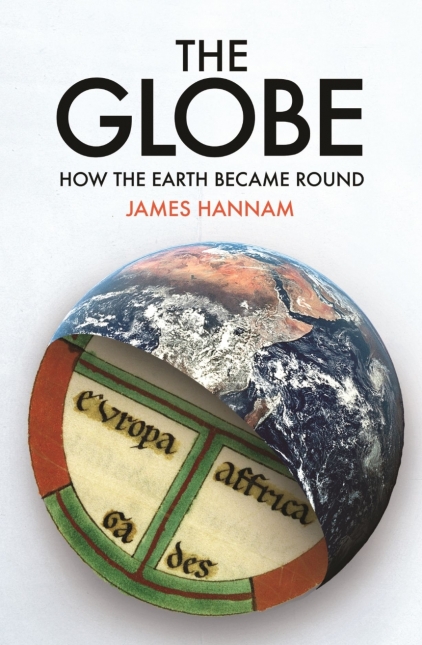The Globe: How the Earth Became Round
- By James Hannam
- Reaktion Books
- 376 pp.
- Reviewed by Anne Cassidy
- October 12, 2023
Our fascinating journey toward a spherical world.

According to family lore, one of my great-great-grandfathers went to his grave believing the earth is flat. This is not something I usually admit, but author James Hannam might not be surprised by it. In The Globe: How the Earth Became Round, he reminds us that though we may sneer at our flat-earther forebears, it was a huge intellectual leap to recognize that our planet is round given the everyday sensory evidence that it is not. Looking down on the earth’s surface, even from a tall mountain, we can discern no curvature.
And if our planet is round, why don’t we fall off?
Hannam opens his book by describing the famous Blue Marble photograph taken by the Apollo 17 crew in 1972. This was the first time humans had captured an image of Earth whole and entire, oceans and land masses in clear relief, swirls of clouds like cotton candy. It was unequivocal proof that our planet is not the flat disc it seems to those living on its surface, but is, in fact, a globe.
But people have known the earth is round for more than 2,000 years, Hannam says, beginning with Aristotle. He built on the thoughts of Plato and other Greek philosophers and on observations that didn’t square with a flat earth — the curvature of Earth’s shadow on the moon during a lunar eclipse, for example — to produce a model in which a round earth made sense.
In Aristotle’s cosmos, Earth is the center of a huge, spherical universe, and “down” is not perpendicular to the ground but an attraction toward a central point. Since “solid objects moved towards the heart of the heavens from all directions,” Hannam says, “this necessarily meant they coalesced into a sphere,” and the earth must be a ball, not a disc resting on a cushion of air or water.
Aristotle by no means settled the question, but the theory of the globe was never independently developed anywhere else, underlining the significance of the philosopher’s achievement. A few-hundred years later, the notion of a round earth was common enough that Roman coins routinely featured globes, and the theory eventually spread beyond the Roman Empire to, for instance, India and Persia, where astronomers used it to improve their calendars and astrological predictions.
Hannam explodes the myth that most people thought the earth was flat until Columbus proved it otherwise. Though the globe theory took a hit after the fall of Rome, Middle Age scholars like the Venerable Bede helped resurrect it, and by the high medieval period in Western Europe, “anyone with a modicum of education learnt about the Globe early in their careers.”
Potential funders of Columbus’ expedition, therefore, didn’t hesitate because they thought the navigator would sail off the edge of the earth but because they feared the journey he was proposing was too long to sustain.
In terms of round-earth theory, Columbus’ voyage wasn’t the only significant event to take place in 1492. That was also the year the oldest surviving terrestrial globe appeared. Named Erdapfel (earth apple), the globe was remarkably accurate despite its exclusion of the Americas (since Columbus didn’t return with news of his discovery until 1493).
Hannam is not afraid to discuss in these pages some of the more amusing geographical conundrums. One of these was the ancient world’s fascination with people who live on the other side of the planet: the antipodes. Were they walking around upside-down? Pliny the Elder said if there were such people, they’d be wondering the same about us.
Throughout the book, Hannam explores the role of religion and culture in scientific thinking. Manicheans and Zoroastrians had trouble reconciling a spherical world with their beliefs. The Chinese clung to their perception of a square earth and circular heaven until the 18th century. Saint Augustine knew about the round world from Aristotle, but because it didn’t sit well with a literal reading of the Bible, he kept quiet about it. In general, though, religion has squelched science less often than we think, Hannam asserts.
As colonial rule spread across the earth, so did a belief in the planet’s roundness. But there were holdouts. Many 19th-century flat-earthers were fundamentalist Christians (my great-great-grandfather included), but modern folks who still cling to that notion — and, yes, there are some — tend to be conspiracy theorists who also believe the moon landings were faked and that 9/11 was an inside job.
Hannam writes with verve and precision. He has compressed an impressive amount of scholarship into this compact volume of intellectual history. Reading The Globe, I couldn’t help but think how hard it is to see ourselves as we really are, and how helpful it is to have guides like him to keep us humble.
“We don’t believe the planet is round because we’re more clever or rational than the people who came before us,” Hannam writes, “we’re just lucky enough to live in a society that takes it for granted.”
Anne Cassidy has been published in many national magazines and newspapers, including the Washington Post, the New York Times, and the Christian Science Monitor. She blogs daily at “A Walker in the Suburbs.”

